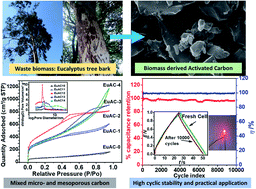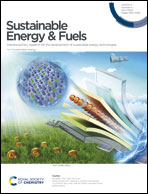Hierarchical porous carbon derived from eucalyptus-bark as a sustainable electrode for high-performance solid-state supercapacitors†
Abstract
We report the synthesis and characterization of novel activated carbon derived from waste eucalyptus bark through chemical and physical activation processes to use as a potential electrode for symmetric electrical double layer capacitors (EDLCs). A porous polymer film prepared by a simple phase-inversion method and activated by an ionic liquid electrolyte has been used as a flexible, high ion-conducting, mechanically and electrochemically stable electrolyte for EDLCs. The use of waste eucalyptus bark to produce activated carbon (AC) with a straightforward activation process, and a simple phase-inversion method to produce porous polymer electrolytes (PPEs), make possible the preparation of eco-friendly, safe, and flexible EDLCs. The derived AC powder possesses a hierarchical porous interior having micro- and meso-porosity. An EDLC, constructed using the optimized AC, shows a high specific capacitance of ∼155 F g−1 and offers a better rate capability than commercial AC-based devices. EIS studies reveal superior charge-transfer characteristics of optimized AC electrodes, as compared to the commercial AC. Galvanostatic charge–discharge measurements highlight the high specific energy and maximum power (∼32.8 W h kg−1 and ∼57 kW kg−1, respectively) of the optimized AC based EDLC. This device maintains its performance for at least 10 000 charge–discharge cycles with high (96%) capacitance retention.



 Please wait while we load your content...
Please wait while we load your content...